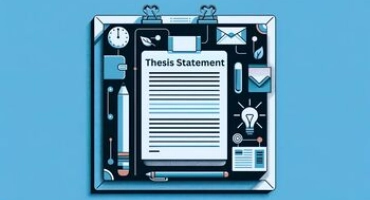How to Write a Critical Analysis Essay: From Structure to Template
Table of contents
- 1 Critical Essay is the Report, Right?
- 2 How to Start Writing a Critical Analysis Essay?
- 3 Don’t Write Right Away
- 4 Think About the Title
- 5 Structure
- 6 Potential Points of Criticism
- 7 How to write a perfect essay? Follow the three steps described below
- 8 Use This Template
- 9 Proofread and Polish Your Critical Analysis Essay
- 10 How To Format A Critical Analysis Essay?
Imagine receiving an assignment to write a critical analysis essay with a short turnaround. Does this idea make you panic? If the answer is YES, you are in the right place to solve this problem! Many students facing tight deadlines choose to pay someone to write essay while learning the key principles themselves.
A critical analysis essay is an academic paper for college students. It aims to demonstrate a student’s ability to analyze a piece of literature or cinematography.
Why do lecturers love to assign this task so much? Simply because this type of written task makes students engage critically in the coursework. A good critical analysis essay gives the reader a nuanced understanding of the piece. It reflects work’s positive and negative aspects.
Critical Essay is the Report, Right?
No!
You shouldn’t confuse a critical essay with a report. They both deal with books, articles, movies, or even paintings. Yet, a report typically presents information straightforwardly and objectively. Meanwhile, a critical essay goes beyond mere summary. Here’s a more concise thermal comparison:
| Aspect | Critical Essay | Report |
| Purpose | Critically analyze and evaluate a text. | Present factual information and findings. |
| Thesis Statement | Requires a strong, clear thesis guiding the analysis. | May include a descriptive purpose statement. |
| Structure | Introduction, body paragraphs for detailed analysis, and conclusion. | Structured format with sections like introduction, findings, and conclusion. |
| Content | Focuses on critical analysis and evaluation of specific aspects. | Focuses on presenting data and observations. |
| Language | Uses academic language and critical thinking skills. | Uses clear, concise language for straightforward information. |
| Audience | Written for an academic audience expecting nuanced analysis. | Written for an audience seeking clear, factual information. |
| Analysis | In-depth analysis considering broader implications. | Basic analysis, focusing on reporting findings. |
| Style | Builds a coherent argument supported by evidence. | Presents information in a straightforward, often segmented manner. |
So, I Have to Write a Critical Essay. Where Should I Start?
You are at the right place, where you can learn how to write successful critical analysis essays quickly!
PapersOwl’s guide created a special guide with the help of several professional writers and lecturers of different scientific fields!
Follow it to be at the top and receive the best mark for your critical essay! Let’s begin!
How to Start Writing a Critical Analysis Essay?
Critical essay writing is a captivating process. But to make this process pleasant, you must have a basic understanding of the writing process.
You should know the right structure and use the experience of qualified experts who understand all the intricacies of writing essays. But let’s start with the beginning. It is one of the most important parts because it is when you put a solid foundation for your essay. How to start your essay with impact? Check out examples of hooks for essays to make it a powerful piece of work.
Don’t Write Right Away
That’s right! Don’t fall just into critical writing. Firstly, read! If you have to critically evaluate a piece of writing such as a novel, a play, a poem, or academic writing, you should first read it carefully. Some advice from us to make your reading as effective as possible:
- Arm yourself with stickers, a notebook, and a pen or pencil.
- Concentrate on the given topic of your essay and make notes of the essential parts of the book.
- Pay attention to unfamiliar terms and concepts.
- Make sure that you have a deep understanding of the piece you need to analyze after reading it.
Think About the Title
Then, you can consider the title. The title of the critical analysis paper should focus on your ideas. This will help your reader or another researcher clearly envision the essay’s analysis.
For instance, critical analysis in literature may deal with the following works:
- Hamlet by William Shakespeare;
- Frankenstein by Mary Shelley;
- The Great Gatsby by F. Scott Fitzgerald;
- The Lord of the Rings by J. R. R. Tolkien.
Your critical analysis essay topics can look like these:
- “The Tragic Flaw: Exploring Hamlet’s Internal Conflict and Its Impact on His Fate”.
- “The Monster Within: Analyzing the Themes of Creation, Isolation, and Identity in Frankenstein”.
- “The Illusion of the American Dream: A Critical Examination of Wealth and Morality in The Great Gatsby”.
- “Power and Corruption: A Critical Analysis of the Struggle Between Good and Evil in The Lord of the Rings”.
You can improve your heading after writing, structuring, and polishing your work. You may ask how to structure critical analysis essays or explore various analytical essay topics. PapersOwl is right here to answer that!
Structure
The best type of critical analysis essay sample structure is:
- Introduction Paragraph:
- Start with a clear thesis statement. Introduce the main argument and provide essential background information. Set the stage for your critical analysis.
- Body Paragraphs:
- Each paragraph should focus on a specific aspect of the work. Discuss the main points and support them with relevant evidence. Analyze literary devices and their impact. Ensure the essay flows logically from one point to the next.
- Central Argument:
- Build your central argument with analytical prowess. Use clear and concise language to evaluate the text critically. Provide evidence to support your claims and consider broader implications.
- Conclusion:
- Summarize the main points and restate the thesis. Offer final thoughts and suggest further research if necessary. Conclude by reflecting on the broader significance of your analysis.
- Critical Essay Outline:
- Organize your essay with a strong thesis statement, structured body paragraphs, and a compelling conclusion. This will help you maintain focus and ensure clarity throughout your writing.
The structure of critical analysis essay writing may differ based on your institution’s requirements. Follow your assignment guidelines and consider suitable opinion essay topics for students to ensure the correct structure!
Potential Points of Criticism
Yes, it may seem strange to “criticize” a book or article. Usually, you will analyze the work of a professional and experienced writer. Still, the part of the exercise is to show that even profs are still advancing an argument. Do not be afraid of criticizing. You just need to know how to criticize!
You must be aware of potential areas for criticism that could impact the effectiveness of your analysis. Identifying and addressing these points can significantly enhance the quality of your work:
| Aspect | Potential Points of Criticism |
| Writing Style | Check for grammatical errors and overall clarity. Ensure the style is consistent and appropriate for academic writing. |
| Thesis Statement | Evaluate the strength and clarity of the thesis statement. Does it provide a clear direction for the essay? |
| Evidence | Assess whether the evidence effectively supports the key points. Ensure the use of external sources is appropriate and relevant. |
| Analysis Depth | Critique the depth of literary criticism. Are body paragraphs well-developed with in-depth analysis? |
| Structure | Ensure the essay follows a logical structure. Verify that the critical essay outline is coherent and easy to navigate. |
| Argument Coherence | Determine if the main argument flows logically throughout the essay. Check the connection between key points. |
| Context | Evaluate if the essay addresses relevant cultural or historical context. Consider if important aspects like mental health are covered. |
| Conclusion | Review the conclusion for summarizing key points. Suggest what else can be researched. Ensure it wraps up the argument effectively. |
How to write a perfect essay? Follow the three steps described below
- Critical reading
To create a good paper, it is not enough to simply read a book. You have to read the work with the following goals critically:
- To identify the key ideas;
- To determine the author’s main thesis;
- To identify the appeals the author utilized;
- To evaluate the author’s success in conveying his or her message.
These are the main goals you should keep in mind while reading. We also recommend researching all unfamiliar terms, words, and concepts to understand your topic better.
- Make an Outline
With a good plan, you can easily write this paper. First, consider the format of your work. As a rule, essays of this type have a standard structure that consists of an introductory paragraph, a few body paragraphs, and a conclusion paragraph. Use this standard structure to make a detailed outline.
- Write your paper
While writing your paper, you should pay special attention to the introduction and the main body paragraph because they require the most attention and effort.
Use This Template
Here is a template for you so the critical essay writing process becomes much easier:
Introduction
- Start with a strong thesis statement.
- Introduce the literary work and its cultural context.
- Mention the main argument and key elements you’ll analyze.
Body Paragraphs
- Focus each paragraph on a single main point.
- Analyze specific literary elements like themes, symbols, or character development.
- Provide evidence from the text to support your analysis.
- Discuss the historical and cultural context, if relevant.
- Identify patterns and their significance to the main argument.
Conclusion
- Summarize the key points of your analysis.
- Restate the thesis in light of your discussion.
- Reflect on the cultural significance of the work.
- Suggest areas for further research or critical writing.
Final Steps
- Review your critical analysis writing to ensure it follows the critical essay outline.
- Seek feedback to refine your writing style and argumentation.
- Edit for clarity and consistency in academic writing.
Now, you are ready to submit your excellent critical analysis essay!
To ensure you’ve got the point of writing the critical essay, we have a video for you: How To Write A Critical Analysis Essay – PapersOwl from PapersOwl on Vimeo. Check it out to make the most of our guide!
Main Tips for the Whole Writing Process
To make your path as stressless as possible, we offer you these small tips:
- Make time for writing your critical analysis in order to concentrate on the work;
- Follow the required instructions and structure;
- Make sure that you evaluate the author’s work rationally.
Writing a critical analysis essay requires a great deal of practice and effort. You need to analyze the material and draw your own conclusions properly.
Fortunately, experienced essay writing services, like PapersOwl, can provide you with their expertise to help you create an outstanding critical analysis essay. You can buy customized essays tailored to your needs, ensuring you have the proper guidance and support to construct a top-quality essay.

Proofread and Polish Your Critical Analysis Essay
Take a few days to rest from writing. After you have refreshed your mind, read the essay a few times to identify whether or not there are some mistakes to fix or if something is missing.
Be attentive to the smallest details. Additionally, don’t hesitate to ask someone else to edit your essay. Even professional writers and journalists utilize professional editing services.
Once you have identified the flaws in your text, take a few hours to revise your work and make the necessary edits until your text is perfect.
With these steps, you should create an “A” mark paper with ease.
However, here are a few additional tips to make your writing process more effective:
- Start in advance and find a good work of literature you can reflect on.
- Include smooth lead-ins and transitions to make your text flow as a single unit.
- Be precise and clear.
Follow a logical sequence of presenting information and don’t neglect proofreading. If you follow all of these guidelines, you are sure to succeed.
How To Format A Critical Analysis Essay?
So, you put your final thoughts in your essay. Still, there is some work to do. Time to format your work.
The idea behind this paper is to reflect your opinion on a specific text. Your essay has to be:
- Well-structured;
- Reasoned;
- Clear.
You shouldn’t focus only on the negative points. You can agree or disagree with the writer but each claim or point you make has to be supported by strong evidence and arguments that prove your analysis of the author’s point.
You can use this sample to format your essay:
I) Essential background information:
A) Work (title, author, publication details, topic, and purpose)
B) Your thesis statement that indicates your opinion about the piece
II) Clear description and summary of the analyzed work.
III) Evaluation and/or interpretation of the work:
A) Work’s organization
B) Author’s style
C) The effectiveness of the work
Discussion of how the author wrote the topic and explained the main messagee;
E) Discussion of how the author appeals to the audience
If you need help in writing a critical analysis essay, you can use the services of professional case study writers on PapersOwl. These writers have extensive experience in crafting critical essays that are custom-written according to your instructions.
Moreover, they ensure that their work will pass any plagiarism check. They guarantee quality and timely delivery of your essay.
Each student should know how to cope with critical analysis. Many of them decide to write my essay through professional academic writing services to complete this assignment quickly and save time.
A critical analysis essay is a popular assignment in all educational institutions and is an important aspect of most educational programs. While writing, students not only enhance their writing skills but also develop many other skills including critical reading, critical thinking, and analyzing. All these skills are crucial not only in high school or college but in your future career as well.
Therefore, consistently practicing critical analysis is crucial for students!







